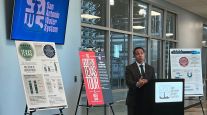Utility Trailer Is Spending $13 Million in 2012 to Update, Improve Production at Factories
This story appears in the Dec. 17 print edition of Transport Topics.
CITY OF INDUSTRY, Calif. — Utility Trailer Manufacturing Co. said it is spending $13 million this year to update and improve its production, including the use of post-assembly line modification centers, for its lineup of refrigerated, dry van, flatbed and curtainside trailers.
The company expects to sell about 35,000 total units in 2012, up from about 30,000 in 2011, Senior Vice President Craig Bennett said in an interview here near the company’s headquarters.
“We’re very busy right now. The orders we’re getting now are for spring delivery,” Bennett told Transport Topics, indicating that deliveries will continue at a good clip beyond the normal year-end rush for tax purposes and into 2013.
Industrywide, orders for new trailers rose 21.1% in October to 23,597, the highest total since January. Year-to-date, orders were 186,271, up 2% from a year earlier, according to ACT Research.
Dry vans are providing most of Utility’s growth now as fleets replace aging units, following a hard fall through 2009 due to the recession.
The refrigerated line, which has long led Utility’s sales, is now growing more slowly but did not fall as hard during the recession.
Reefer trailers account for 55% of Utility’s production, dry vans are 38%, and flatbed and Tautliner curtainside trailers combine for the remaining 7%, Bennett said on Dec. 5.
Utility will celebrate its 100th birthday in 2014, and Bennett is the third generation at the helm. Members of the fourth generation are already being groomed to lead. He said the family wants Utility to remain privately held.
His brother, Harold, is president of the company, and their cousin, Paul, is CEO.
For about two-thirds of its first century, Utility was a custom trailer maker, producing any type of trailer for which a customer might ask. That changed in 1980, when management decided to consolidate the company’s offerings, boosting profitability.
But with the use of modification centers, some of that customization can come back, Craig Bennett said. The company has five U.S. trailer factories, each specializing in reefers, vans or flatbeds.
The modification centers, located adjacent to the plants, are used for final customization. That means the assembly lines can run at a constant rate of speed while the final details, including the application of customers’ decals, are applied afterward off the line.
“We want to deliver our trailers road-ready. The modification centers make for more capacity on the line,” Bennett said.
The company makes refrigerated trailers in Clearfield, Utah, and Marion, Va. Dry vans are manufactured in Glade Spring, Va., and Paragould, Ark. Flatbeds are made in Enterprise, Ala.
Bennett said California is a high-cost state in terms of taxes, labor and regulations, so Utility has had to minimize its manufacturing in its home state.
“I’m not sure that you can manufacture anything profitably in California anymore,” he said. He also said manufacturers have their own version of the driver shortage in trucking.
“For factory jobs, we might have to interview 30 to 40 people to find one who will stick. Welders are particularly hard to find, and we have to do on-the-job training because people aren’t as mechanically inclined as they used to be,” Bennett said.
But an exception is its curtainside assemblies, which are in Walnut, Calif., and then shipped to Enterprise, Ala., for final installation.
Half of the trailers are shipped one at a time to customers, while fleets send drivers to the plants to pick up the other half.
Some of the refrigerated trailers will spend parts of their lives on railroads, as that segment is one of the last holdouts in trailers on flatcars, Bennett said. Dry freight is usually transported in intermodal shipping containers rather than trailers when it hits the rails. Utility does not make containers.
Trailers are sold through a network of 100 independently owned North American dealerships, and Utility even sells in South America, as far south as Chile.


